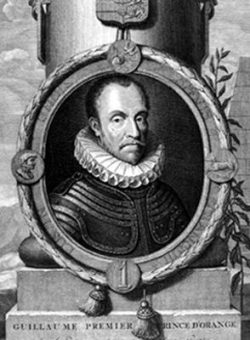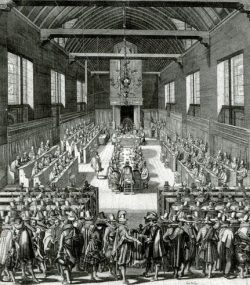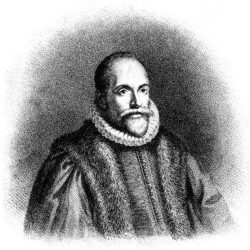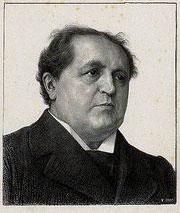Protestantism
in the Low Countries
The history of Dutch protestantism basically consists of a long-drawn out battle against Spain, who held sway over the country in the second part of the XVIth century and at the beginning of the XVIIth century ; independence was finally achieved by the United Provinces, who later became the kingdom of Holland. During the XVIIth century, Calvinism gradually became the main religion.
The Reform movement and the war against Spain
Luther’s ideas took hold early on in the Seventeen Provinces of the Low Countries (Belgium, Holland, Luxemburg and the North of France), which were all under the control of Charles Quint.
From 1521 onwards, Charles Quint published notices (placards) forbidding these new ideas and in 1525 the first Lutheran protestant was burnt alive in the Hague. From 1550 onwards, Calvinism took hold in the country, first in the south of the Walloon province, where there were French-speaking pastors, then spreading throughout the Provinces. The pastor Guy de Brès (1522-1567) was put to death in Valenciennes : his work “Confessio belgica” (1561) became the basic expression of faith in the Low Countries.
The extension of Calvinism went hand in hand with resistance against the Spanish government of Philip II. The prince of Orange, William of Nassau, (known as William the Silent) prince of the Empire, was greatly admired as a leader in the Low countries. He fought against the Inquisition and the Duc d’Albe’s repression of protestants (many aristocrats were put to death, namely Lamoral d’Egmont) ; 100,000 subjects had to flee to England and Germany. Those most concerned by the persecution were the Anabaptists, a radical movement which received the support of many nationalists. William and the aristocracy (known under the pejorative nickname of “villains” Gueux) issued a proclamation calling for the freedom of religious belief and civil rights ; he then declared war against Spain. This was called the Eighty Years War (1568-1648) and did not prove easy to win for the Low Countries (William the Silent was assassinated in 1584). Since the Calvinists had been at the heart of the rebellion and were greater in number than the Lutherans, their religion gradually became the strongest one in the country.
The beginning of the United Provinces
Due to the presence of two separate religions in the country, the Seventeen Provinces were destined to divide into two separate states : the southern provinces (Artois, Flanders, Hainaut, the Walloons) remained catholic and became the Union d’Arras. The seven provinces of the North, however (Holland, Zelande, Gueldre, Utrecht, Frise, Overijssel and Groningue) remained Calvinist and became the Union of Utrecht: the future separation of the Low Countries into two nations had already been set in motion. If William had not been assassinated by a catholic (1584), he would most certainly have been chosen as king. In his absence, the United Provinces declared themselves a Republic (1588): a confederation in which each province remained independent but all of them together were governed by a “stathouder” who was in charge of the army and a “pensioner” who dealt with foreign affairs.
The Reformed Church, which formed part of the secular authorities (synod of Dordrecht 1618) was officially recognized and individual religious freedom was guaranteed. Indeed, this religious freedom had become part of the national consciousness and evolved at the same time as the development of a spirit of tolerance concerning spiritual, scientific and artistic matters (the “Golden Age”, with Spioza, Descartes, Locke, Huygens, Rembrandt). Nevertheless, the main religion was Calvinism : Catholics, Mennonites and Lutherans were tolerated but not allowed to enter public service or receive financial help, unlike the official Reformed Church, to which all the political leaders belonged (the “stathouder”, the members of the States General and the leaders of the government in the provinces). This privileged position enabled Calvinism to develop into the main religion of the country during the second part of the XVIIth century. As it was a thriving Church and also in part French-speaking (the Walloon Churches), it attracted many French refugees at the time of the Revocation of the Edict of Nantes, among the most sell-known were the professors of theology Pierre Bayle and Pierre Jurieu.
The Arminian dispute
At the beginning of the XVIIth century, a major event in ecclesiastical life was the dispute between strict Calvinists and the followers of Johannes Arminius (1562-1609), known as the “remonstrants”, who did not accept the Calvinist doctrine of predestination. They represented a moderate tendency in the Reformed Church and asserted that man was free before God and the Church. Maurice de Nassau, the son of William the Silent, took advantage of this dispute to relieve the “pensioner” Oldenbarnevelt of his functions ; as a result the “remonstrants” also fell out of favour and were considered to be in the wrong doctrinally at the synod of Dordrecht (1618) : this decision was to have far-reaching repercussions in the Eglise Réfomée de France and in most European countries. Later, they came to be accepted and founded “the Remonstrance Church” which still exists today and has 10,000 members.
Due to the alliance with France during the Thirty years War, the United Provinces were considered to be independent of the treaty of Munster.
In the second part of the XVIIth century, the puritans influenced the country and little groups formed with a more emotional form of piety and a stricter moral code – some even went so far as to break off from the Reformed Church.
The XIXth century: the Partition of Holland and Belgium
The “stathouder” system of government was not a very strong one. First the French revolution set up a Batavian republic, then Napoleon put into place the kingdom of Holland for the benefit of his brother Louis. Then the congress of Vienna instituted the monarchy, the United Kingdom of the Low Countries and the son of the “stathouder” who had been dethroned by the French, was crowned as William Ist. This kingdom was an artificial structure which did not take into account religious, linguistic or economic differences. Following on to the July 1830 revolution in Paris, a riot broke out in Brussels; a provisional Belgian government proclaiming the independence of Belgium was established on the 4th October – the Low Countries were from then on no longer one united country as before. In the Low Countries William Ist put the Reformed Church under government control and more than half the population remained members. It was a synodal type of Church and became gradually more liberal politically ; this led to many disputes in the XXth century between revivalists and liberals.
The problem of education stirred up controversy between “modern” liberals, “confessing” orthodox members and the centre group, known as “evangelicals”. Abraham Knyper (1837-1920), a pastor and a politician, drew together those who opposed religious and political liberalism. In 1880 he set up the Université Libre d’Amsterdam and in 1885 the neo-Calvinist Church, which was separate from both Church and State. Due to his union with the anti-revolutionary political party, he had considerable influence over social and political life. Other groups also broke away ; giving rise to many communities which all shared fundamentalist ideas, some to a greater extent than others.
After the Second World War
Religious instruction was no longer included in the programs of public schools from 1956. Catholics and Protestants drew closer to each other in a general spirit of tolerance.
Today, out of a population of 16 million inhabitants, 3.5 million are protestant and 5.2 are catholic, who live mostly in the south of the country.
The main protestant Church is the Protestant Church of the Low Countries, with 2.5 million members. Due to the union in 2004 of several Churches which had been working together since 1961, it is made up of :
- The Dutch Reformed Church,
- The Reformed Churches of the Low Countries, who are more fundamentalist,
- The Evangelical Lutheran Church in the Kingdom of the Low Countries, a minority Church.
The constitution of the Protestant Church of the Low Countries respects different theological tendencies in its parishes. About 5 per cent of the old Churches have refused to join and have grouped together in the re-established Reformed Church. There are also many other protestant Churches : Mennonites, Evangelicals and Pentecostals.
The Walloon French-speaking Churches are a case apart. At the time of the partition of the Low Countries, a small number of francophone Calvinists left the south of the country (which was predominantly catholic) and settled in the towns of the north, particularly in Amsterdam French is still spoken, but the Churches are now Dutch and are part of the Protestant Church of the Low Countries.
Bibliography
- Sites
- Site des Églises wallonnes au Pays-Bas | Link
- Books
- MILLER John, L’Europe protestante aux XVIe et XVIIe siècles, Belin-De Boeck, 1997
- MOURIQUAND Jacques et PIVOT Laurence, L’Europe des protestants de 1520 à nos jours, Jean-Claude Lattès, 1993
Associated notes
-
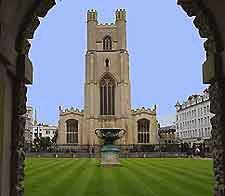
Protestantism in England in the 19th century
Alongside the radical reform within the Church of England, two significant movements developed within it: the first was the Oxford movement, which advocated drawing closer to the Catholic Church, and... -
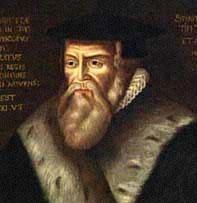
Protestantism in the Scandinavian countries
At the beginning of the XVIth century, Scandinavia consisted of two kingdoms : one was made up of Norway and Denmark and the other Sweden and Finland. They both loosely belonged... -

Protestantism in Germany
The Lutheran Reformation movement was a crucial event in German history. This theological and religious revolution had a major effect on German politics, language and culture. Today Germany has several... -
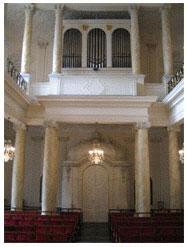
Protestantism in Belgium
Although the Low Countries and Belgium (which was in fact part of the latter for several centuries) had shared a common history in the past, the consequences of the events... -
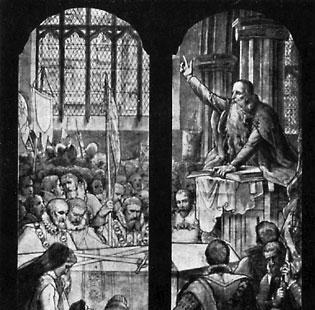
Protestantism in Scotland
The Church of Scotland was founded by John Knox in 1560 ; it is Presbyterian and Calvinist. When the kings of Scotland were also ruling in England they tried to transform... -

Protestantism in Hungary
By the end of the XVIth century, protestantism had spread throughout most of Hungary. Despite the opposition of the Counter-Reform movement in the XVIIIth century and persecution by the Habsbourgs,...

